Music of Spain
This article includes a list of general references, but it lacks sufficient corresponding inline citations. (April 2019) |

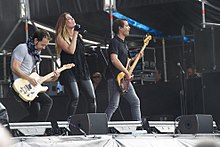
In
Origins of the music of Spain

The
Medieval period
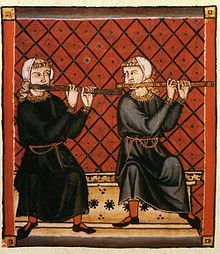
Isidore of Seville wrote about the local music in the 6th century. His influences were predominantly Greek, and yet he was an original thinker, and recorded some of the first details about the early music of the Christian church. He perhaps is most famous in musical history for declaring that it was not possible to notate sounds, an assertion which revealed his ignorance of the notational system of ancient Greece, suggesting that this knowledge had been lost with the fall of the Roman Empire in the west.[citation needed]
The
Renaissance and Baroque periods
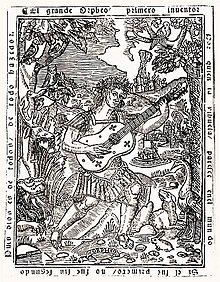
In the early
An early 16th-century polyphonic vocal style developed in Spain was closely related to that of the Franco-Flemish composers. Merging of these styles occurred during the period when the Holy Roman Empire and the Burgundy were part of the dominions under Charles I (king of Spain from 1516 to 1556), since composers from the North of Europe visited Spain, and native Spaniards traveled within the empire, which extended to the Netherlands, Germany and Italy. Music composed for the vihuela by Luis de Milán, Alonso Mudarra and Luis de Narváez was one of the main achievements of the period. The Aragonese Gaspar Sanz authored the first learning method for guitar. Spanish composers of the Renaissance included Francisco Guerrero, Cristóbal de Morales, and Tomás Luis de Victoria (late Renaissance period), all of whom spent a significant portion of their careers in Rome. The latter was said to have reached a level of polyphonic perfection and expressive intensity equal or even superior to Palestrina and Lassus [citation needed]. Most Spanish composers returned home from travels abroad late in their careers to spread their musical knowledge in their native land, or in the late 16th century to serve at the Court of Philip II.
18th to 20th centuries

By the end of the 17th century the "classical" musical culture of Spain was in decline, and was to remain that way until the 19th century. Classicism in Spain, when it arrived, was inspired by Italian models, as in the works of Antonio Soler. Some outstanding Italian composers such as Domenico Scarlatti and Luigi Boccherini were appointed to the Madrid royal court. The short-lived Juan Crisóstomo Arriaga is credited as the main beginner of Romantic sinfonism in Spain. [citation needed]
Although symphonic music was never too important in Spain, chamber, solo instrumental (mainly guitar and piano) vocal and opera (both traditional opera, and the Spanish version of the singspiel) music was written by local composers. Zarzuela, a native form of opera that includes spoken dialogue, is a secular musical genre which developed in the mid-17th century, flourishing most importantly in the century after 1850. Francisco Asenjo Barbieri was a key figure in the development of the romantic zarzuela; whilst later composers such as Ruperto Chapí, Federico Chueca and Tomás Bretón brought the genre to its late 19th-century apogee. Leading 20th-century zarzuela composers included Pablo Sorozábal and Federico Moreno Torroba.
Musical creativity mainly moved into areas of popular music until the nationalist revival of the late Romantic era. Spanish composers of this period included
Performers
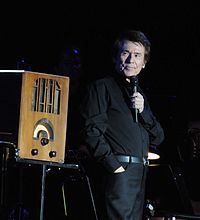
In the field of classical music, Spain has produced a number of noted singers and performers. In Spain there are over forty professional orchestras, including the
Ye-yé

From the English pop-refrain words "yeah-yeah", ye-yé was a French-coined term which Spanish language appropriated to refer to uptempo, "spirit lifting" pop music. It mainly consisted of fusions of American rock from the early 1960s (such as
Popular music in Spain
This section is written like a personal reflection, personal essay, or argumentative essay that states a Wikipedia editor's personal feelings or presents an original argument about a topic. (September 2015) |
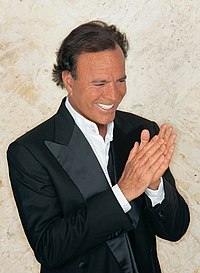
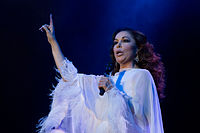

Although Spanish pop music is currently flourishing, the industry suffered for many years under
During the 1960s and early 1970s, tourism boomed, bringing yet more musical styles from the rest of the continent and abroad. However, it was not until the 1980s that Spain's burgeoning pop music industry took off with a cultural movement known as
Music by region
The regions of Spain have distinctive musical traditions. There is also a movement of singer-songwriters with politically active lyrics, paralleling similar developments in Latin America and Portugal. The singer and composer Eliseo Parra (b 1949) has recorded traditional folk music from the Basque country and Castile as well as his own compositions inspired from the musical styles of Spain and abroad.
Andalusia


Though
Sevillanas is related to flamenco and most flamenco performers have at least one classic sevillana in their repertoire. The style originated as a medieval Castilian dance, called the seguidilla, which was adopted with a flamenco style in the 19th century. Today, this lively couples' dance is popular in most parts of Spain, though the dance is often associated with the city of Seville's famous Easter feria.
The region has also produced singer-songwriters like Javier Ruibal and Carlos Cano, who revived a traditional music called copla. Catalan Kiko Veneno and Joaquín Sabina are popular performers in a distinctly Spanish-style rock music, while Sephardic musicians like Aurora Moreno, Luís Delgado and Rosa Zaragoza keep Andalusian Sephardic music alive.
Aragon
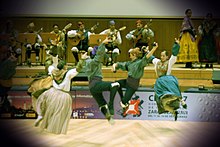
Asturias, Cantabria and Galicia

Northwest Spain (
There are local festivals of which Ortigueira's Festival Internacional do Mundo Celta is especially important. Drum and bagpipe couples range among the most beloved kinds of Galician music, that also includes popular bands like Milladoiro. Pandereteiras are traditional groups of women that play tambourines and sing - bands like Tanxugueiras are directly influenced by this tradition. The bagpipe virtuosos Carlos Núñez and Susana Seivane are especially popular performers.
nights" in Asturias.Balearic Islands
In the
Basque Country
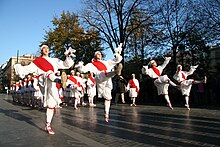
The most popular kind of
Basques on both sides of the Spanish-French border have been known for their singing since the
Canary Islands
In the
Castile, Madrid and León
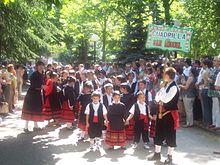
A large inland region,
Catalonia
Though
Catalan
The
Extremadura
Having long been the poorest part of Spain,
Murcia

Valencia
Traditional music from
References
- ISSN 0006-2510. Retrieved 4 September 2015.
- ^ Llewellyn, Howell (11 November 2000). "The Spanish Market Looks To Export Artists". Billboard. Vol. 112, no. 46. p. 78. Retrieved 9 April 2015.
- ISBN 9780470766026.
- ISSN 0006-2510. Retrieved 30 July 2015.
- ISSN 0006-2510. Retrieved 3 September 2015.
- ^ Garza, Agustin (18 May 2002). "Latin Grammys Struggle With Loss of Momentum". Los Angeles Times. Retrieved 25 December 2013.
- ^ "Julio Iglesias receives world record certificate in Beijing". Guinness World Record. 2 April 2013. Retrieved 24 December 2013.
- Fairley, Jan "A Wild, Savage Feeling". 2000. In Broughton, Simon and Ellingham, Mark with McConnachie, James and Duane, Orla (Ed.), World Music, Vol. 1: Africa, Europe and the Middle East, pp 279–291. Rough Guides Ltd, Penguin Books. ISBN 1-85828-636-0
- Fairley, Jan with Manuel Domínguez. "A Tale of Celts and Islanders". 2000. In Broughton, Simon and Ellingham, Mark with McConnachie, James and Duane, Orla (Ed.), World Music, Vol. 1: Africa, Europe and the Middle East, pp 292–297. Rough Guides Ltd, Penguin Books. ISBN 1-85828-636-0
- Alan Lomax: Mirades Miradas Glances. Photos and CD by Alan Lomax, ed. by Antoni Pizà (Barcelona: Lunwerg / Fundacio Sa Nostra, 2006) ISBN 84-9785-271-0
- Historia de la Música en España e Hispanoamérica. ed. by Maricarmen Gómez, Alvaro Torrente, Máximo Leza, Consuelo Carredano, Alberto González, Victoria Eli (Madrid-México DF, 2009–2017) ISBN 978-84-375-0637-1
External links
- (in French) Audio clips: Traditional music of Spain. Musée d'ethnographie de Genève. Retrieved 25 November 2010.
- MIDI samples of traditional music from the Iberian peninsula and Extended version
- AlejandroSanz4EnglishSpeakers A collection of translated songs from one of Spain's most famous singers.
- Bloomingdale School of Music Piano Project: Sonidos de Espana/Music of Spain – extensive monthly features on the history of Spanish music.
- Spanish language music Traditional and contemporary Spanish-language music, with genre descriptions, representative artists, CDs & audio samples.
- Spanish Folk Music in Havana (Photo Album)
- Encyclopedia of Spanish Music (16th to 19th centuries)


